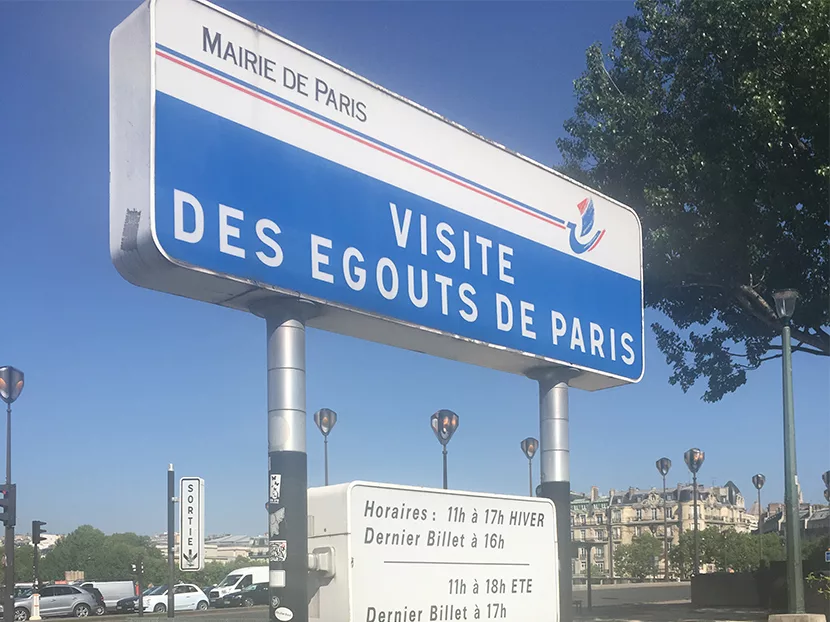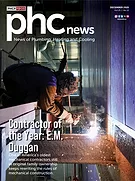Ah, Paris. Home to must-see tourist attractions such as the Eiffel Tower, the Louvre, Notre Dame, the Arc de Triomphe as well as thousands of cafes, shops and restaurants.
Forget all that. Next time any PHCPPro is in Paris, head to the Musee de Egouts de Paris – the Paris Sewers Museum, a fascinating journey into history and engineering.
The museum’s ticket office is along the Left Bank of the Seine River, practically in the shadow of the Eiffel Tower. After paying the equivalent of $6 – a bargain compared to the city’s other museums – visitors walk down a circular staircase. After descending the stairs, they enter a long gallery that runs parallel to the Seine for the start of the tour.
The first item to keep in mind is that it’s just as much an actual sewer as it is a museum. The second item to keep in mind is that this isn’t a boulangerie baking up fresh croissants and baguettes either. Visitors proceed to walk around a third of a mile through the system, often traipsing over metal catwalks above active sewer lines, with historical exhibits put up along the way.
What they get is a timeline of the construction of the system over five centuries along with mannequins wearing present-day safety equipment and displays of machinery used to maintain the tunnels.
A five-ton le bateau-vanne, literally “boat valve,” is the first device visitors see on display in what once was the main sewer line between the Place de la Concorde and the Pont de l'Alma. The dredging boat is used to clean large sewer tunnels. Manned by a team of workers, the boat is secured by chains to the sides of the tunnel.
Another significantly smaller device is la mitrilleuse K.P., literally “machine gun,” followed by the initials of the two designers. The device, looking something like a turned over wheel bar with a snowplow, is fitted with a gate valve that holds the water back. At its base, another gate valve allows a strong current through to push sand and rubbish along the way.
One of the neatest things visitors get to see is a gigantic iron ball used to clean out sewer lines, although it looks more like it should be chasing Indiana Jones through some ruins.
Certain parts of the sewer system, inaccessible to workers, are regularly cleaned using la boule de curage or “cleaning ball.” The big one is hollow iron while a smaller model is made of wood. Both spheres are just smaller than the system’s tubular tunnels. The buildup of water pressure behind the balls forces them through the tunnel network until they emerge somewhere downstream, pushing a mass of sludge along the way.
History lesson
The exhibits broadly trace the history of Parisian sewage from the Middle Ages to the current incarnation, after Baron Eugène Haussmann – the guy best known for reshaping the Parisian cityscape into what it is today – collaborated with another Eugène, the engineer Belgrade, to create a modern and efficient system for managing waste and water runoff.
Circa the 14th century, Paris had a very rudimentary system for water supply and waste disposal, namely, the Seine. Water was drawn from the river and waste dumped in. The population of the city, however, was still small enough that the river could purify the waste biologically.
However, waste on its way to the river was the main problem – it flowed through open gutters on nearly every street.
“The odor became, in many places, unbearable,” says one display. “But there was a worse problem: disease.”
The unsanitary conditions in the city were indirectly responsible for the Black Death, which killed up to 60 percent of the European population in the mid-1300s.
As a result, city streets began to be paved and central drains placed down the middle. In 1370, the first stonewalled underground sewer, almost 1,000 feet in length, was built beneath the rue Montmartre.
Under Napoleon Bonaparte, things began to get interesting beneath Paris. In the early 1800s, he ordered the construction of a network of sewer tunnels totaling 19 miles.
But as the population of the city continued to swell, even those improvements weren’t enough to keep pace. Meanwhile, the Seine, still used for both intake and disposal, became horribly polluted with waste.
A major outbreak of cholera in 1832, which killed 19,000 citizens, finally galvanized the city to find and implement a lasting solution to the problem. By 1850, the two Eugenes were well on their way to designing and building what is largely the present day’s Parisian sewer and water supply network.
By 1878, the system reached 373 miles in length. In 1894, a law was enacted that required all waste to be sent to the sewers. The local saying at the time was that the city was completing its long transition from tout à la rue, “all in the street” to tout à l’égout, “all in the sewer.” The sewer system was hailed as a technological marvel, a brilliant achievement that helped to usher Paris into the modern age.
Flushed with pride
The Paris sewers have always drawn curious tourists since the first public tours were offered in 1897. Back then, tourists rode through the sewers in carts that were suspended along the tunnels. Later, visitors took carriages drawn by a small locomotive.
By 1920, the carriages were replaced with a boat, which floated tourists along until 1975.
The tourists of the past certainly saw much more than tourists of today. But neither could ever expect to take in the whole sewer system, which travels 1,300 miles – longer than the distance between New York and Miami.
The Parisian sewers really are another Paris beneath Paris. Roughly speaking, the tunnels mirror the streets above. Where a wide boulevard runs on the surface, a wide sewer tunnel (or two) runs beneath; smaller streets have smaller sewers, and even side streets and alleys are duplicated underground. Each sewer “street” even has its own corresponding blue and white enamel street sign.
Apart from their primary function, the Parisian sewers have long captured the imagination, figuring prominently in two books that inspired popular, present-day musicals.
Victor Hugo wrote “Les Miserables” in 1862 and used 50 pages to describe the sewers based on information he received from his friend Emmanuel Bruneseau.
Bruneseau was the sewer inspector Napoleon commissioned to explore the tunnels and create an exhaustive map of the sewers as they existed in the early 1800s. Until that time, the sewers had been assembled bit by bit, without a plan or written record, and were widely regarded as a mysterious and dangerous maze.
Indeed, Bruneseau found forgotten medieval dungeons, lost jewels and even the skeleton of an orangutan that had escaped from a zoo several years previously.
For his work, Bruneseau was lauded by Paris as “the Christopher Columbus of the cesspool.”
I haven’t read “Les Miserables,” seen the musical or watched the movie based on the musical, but in one corner of the museum is a picture of Jean Valjean carrying a wounded Marius to safety, along with a map showing the sewers as they were at the time the novel is set.
On the other hand, I have seen about four movies based on Phantom of the Opera back in the day when he wasn’t known for singing. The book was written by Gaston Leroux in 1909. Unfortunately, I didn’t see anything about the Phantom (my only disappointment).
One final item visitors see toward the end of the tour are drinking fountains, which can be found at various spots above ground. The so-called Wallace fountains are public drinking fountains that appear in the form of small, cast-iron sculptures scattered throughout the city. First implemented in the late-1800s, the fountains come in different models, but the most prominent feature statues of four women, representing kindness, simplicity, charity and sobriety. Water flows from the top between the statues.
Like all museums, visitors even get to walk through a gift shop on their way out. Need a tee-shirt? A stuffed rat? Get them here. Of course, there are bathrooms on the way out, too, which is a good thing since visitors are warned at the start of the tour to wash their hands at the conclusion of the tour.
The basics
I took a self-guided tour. However, guided tours are recommended and need to be booked in advance. One guided tour was going on at the start of my visit, but it was all in French. I understand that tours are available in English in the summer months.
The hours, 11 a.m. to 4 p.m., are fairly tight compared to other city museums. At the time of my visit, the museum was closed on Thursdays and Fridays. Plan on spending a good hour walking through the exhibits.








